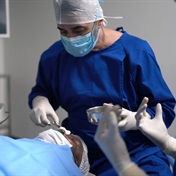In a major advance toward regenerative medicine, researchers have for the first time coaxed stem cells from a mammal into becoming an embryonic eye.
The results, published in Nature, show that growing a complex human organ inside a petri dish, while still a long way off, is no longer the stuff of science fiction.
They also point the way to new treatments for diseases that rob people of sight, and even the possibility of one day restoring vision with transplanted retinas generated from a patient's own stem cells, say outside experts.
In laboratory experiments with mice, researchers led by Yoshiki Sasai of the RIKEN Centre for Developmental Biology in Kobe, Japan began with pluripotent stem cells, the universal starter kit for virtually every specialised cell in an organism.
Stem cells as replacement tissue
Up to now, stem cells have been seen mainly as a potential source of replacement tissue such as muscle, liver or heart composed of a single type of cell.
Generating a more complex set of cells, or an entire organ, was thought to be dependent on complicated chemical interactions with neighbouring tissues during gestation, and thus impossible outside the natural process of cell division and growth.
But Sasai and colleagues, using new lab techniques, managed to set in motion the transformation of mouse embryonic stem cells into a so-called optic cup, the layered, three-dimensional structures that become the retina in an eye.
Significantly, the cells did the work themselves, without being pushed, pulled or "pressurised" into any particular shape, the researchers said.
How the study was done
"What we've been able to do is resolve a nearly century-old problem in embryology by showing that retinal precursors have the inherent ability to give rise to the complex structure of the optic cup," Sasai said.
Starting as a patternless mass, the stem cells organised themselves into the two-walled form that corresponds to the inner and outer layers of the retina during the development of an embryo.
"We are now well on our way to becoming able to generate not only differentiated cell types, but organised tissues" that can be used in regenerative medicine, he said.
Hope for retinitis pigmentosa
The discovery is especially relevant for a group of genetic eye conditions, known as retinitis pigmentosa, that lead to blindness, Sasai added.
The disease attacks vision by damaging the retina, the layer of tissue at the back of the inner eye that converts light images to nerve signals and sends them to the brain.
People with retinitis pigmentosa experience a gradual decline in vision because photoreceptor cells – composed of rods and cones degenerate and die.
"As a step forward in the lead-up to cell replacement or even organ therapy, this is a really significant piece of work," said Richard Lang, director of the visual systems group at the Cincinnati Children's Hospital, after reviewing the study.
"It shows that relatively simple culture conditions can be used to generate whole organ primordia," he said, using the term for the early, embryonic stage of organ development.
Breakthroughs on other tissue types
Lang said the goal of generating human eye tissue remains distant, but noted that other teams of scientists are making parallel breakthroughs on other types of tissue.
"It feels like it won't be long before the first opportunity for experimental clinical use comes along," he said.
In a commentary, also published in Nature, Robin Ali and Jane Snowden of University College London said the new self-generating proto-eye had the signature molecular markers of both the neural retina, which in living animals is linked to the brain, and a layer called the retinal pigmented epithelium, which helps keep the eye free of debris.
"An even more striking proof that these are genuine retinas is that, in culture, the synthetic optic cups undergo cell differentiation ... into all the main retinal cell types, including photoreceptors," they said.
Olivier Goureau, a researcher at the Institut de la Vision in Paris, agreed that the study broke important new ground but cautioned that mice and human eyes differ in key ways.
"The formation of the eye is the same, but most rodents don't use cones, for example, in the same manner as humans," he said by phone.
(Sapa, April 2011)
Read more:




 Publications
Publications
 Partners
Partners














